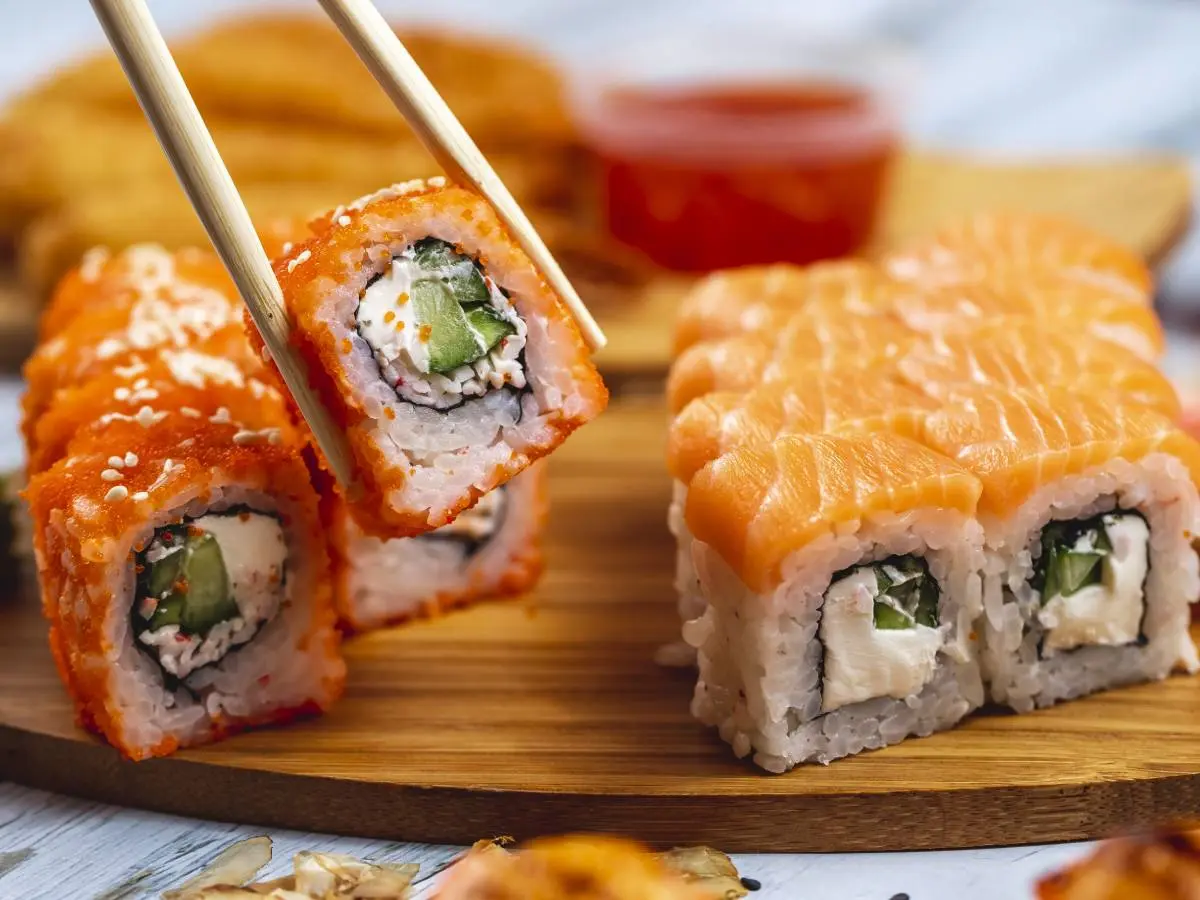Sushi, a culinary art form that has transcended its Japanese origins, has become a global sensation, beloved by food enthusiasts everywhere. At the heart of this delicacy is salmon, a fish revered for its rich flavor and nutritional benefits. However, a common quandary among sushi aficionados and home chefs alike is whether salmon needs to be cooked before it’s rolled into that perfect bite. This article dives deep into the essence of sushi-making, exploring the traditions, health considerations, and culinary techniques that surround the use of salmon in sushi. From the debate between raw versus cooked salmon to the step-by-step guide on preparing it for your homemade sushi, we’ve got you covered. So, whether you’re a seasoned sushi connoisseur or a curious novice ready to roll your sleeves up, let’s embark on this flavorful journey together.
 PinPin
PinPin Pin
Pin
Introduction to Sushi and Salmon
Introduction to Sushi
Sushi, a dish that has elegantly woven itself into the fabric of global cuisine, boasts a history as rich and diverse as its flavors. Originating from Japan, sushi is much more than just food; it’s an art form, a cultural heritage that has been meticulously preserved and passed down through generations. At its core, sushi celebrates the delicate balance of rice, nori (seaweed), and, most importantly, fish, with salmon playing a starring role in many beloved variations.
Understanding Salmon for Sushi
Salmon, known as sake in Japan, is not just any fish; it’s a sushi staple that commands respect and admiration. Its popularity in sushi can be attributed to its velvety texture and the rich, decadent flavor it brings to every bite. However, not all salmon is created equal. The journey of salmon from the ocean to your sushi platter is fraught with considerations of sustainability, safety, and quality.
When it comes to sushi, the term “sushi-grade” often pops up, a label that signifies the highest quality of fish, deemed safe for raw consumption. This distinction is crucial because salmon, like any raw fish, can harbor parasites and bacteria if not handled correctly. Therefore, sourcing salmon from reputable suppliers who adhere to stringent quality control measures is paramount for ensuring both the safety and the success of your sushi.
Moreover, the nutritional benefits of salmon cannot be overstated. Rich in Omega-3 fatty acids, protein, and essential vitamins, salmon is not just a treat for the taste buds but also a boon for health. Whether you choose to enjoy your salmon raw or cooked in your sushi, you’re indulging in a dish that’s as nourishing as it is delicious.
In the next sections, we’ll delve into the heart of the debate: to cook or not to cook your salmon for sushi. We’ll explore the traditional approaches, the safety concerns that might sway your decision, and how to prepare salmon in a way that honors its flavor and texture, ensuring your homemade sushi is nothing short of spectacular. Stay tuned as we unravel the secrets to perfecting your sushi, one roll at a time.
The Debate on Cooking Salmon for Sushi
The Debate: Raw vs. Cooked Salmon
The sushi world is divided, with a heated debate simmering beneath the surface: should salmon be served raw or cooked in sushi? On one side of the sushi mat, traditionalists argue that the essence of sushi lies in its raw purity. Traditional Japanese sushi, after all, is a celebration of the fish’s natural flavors, with raw salmon (or sake) taking center stage in many dishes. This method showcases the fish’s delicate texture and rich taste, which many sushi lovers argue is diminished once cooked.
However, flipping the sushi roll over, there’s a cautious crowd that prefers their salmon cooked. The crux of their argument? Safety. Consuming raw salmon can pose health risks, including exposure to parasites and bacteria. For those erring on the side of caution, cooking salmon becomes not just a preference but a necessity.
Safety First: Risks of Consuming Raw Salmon
Diving deeper into the safety concerns, it’s crucial to understand that not all salmon is suitable for raw consumption. The risk of parasites, such as Anisakis, which can cause severe gastrointestinal issues, looms large. Moreover, bacteria like Listeria can also find a home in raw salmon, posing additional health risks.
The key to navigating these waters safely lies in sourcing. The term “sushi-grade” is often bandied about, implying a level of freshness and quality safe for raw consumption. However, it’s not a regulated term, which means the responsibility falls on the consumer to source their salmon from reputable suppliers. These suppliers adhere to rigorous standards, including deep freezing the fish to kill any parasites.
The debate between raw and cooked salmon in sushi is not just about taste or tradition; it’s a matter of health and safety. As we peel back the layers of this culinary conundrum, it becomes clear that the choice between raw and cooked salmon is deeply personal, influenced by individual comfort levels with the associated risks and the culinary adventure they wish to embark on.
In the next section, we’ll explore how to select the right salmon for your sushi, whether you lean towards the traditional raw approach or prefer the safety net of cooking your fish. Plus, we’ll dive into the various methods of preparing salmon for sushi, ensuring that whichever path you choose, your sushi experience is both safe and sensational. Stay tuned as we continue to roll through the intricacies of sushi-making, one slice of salmon at a time. What are the three ingredients in sushi?
Preparing Salmon for Sushi
Selecting the Right Salmon
Choosing the right salmon for your sushi is akin to selecting a fine wine—it requires knowledge, care, and a bit of finesse. The first step is understanding the term “sushi-grade” salmon. While not regulated, this label is often used by suppliers to indicate fish that has been frozen to kill parasites, making it safer for raw consumption. Here’s what you need to consider:
- Source Responsibly: Opt for salmon from suppliers known for their commitment to quality and safety. These suppliers often use deep-freezing techniques that go beyond the minimum requirements, ensuring their fish is safe for sushi.
- Freshness is Key: Look for salmon that appears vibrant and smells like the ocean—a fresh, briny scent without any hint of fishiness. The flesh should be firm and bounce back when touched.
Preparation Methods for Salmon
Once you’ve sourced your perfect piece of salmon, the next step is preparation. Whether you decide to cook your salmon or serve it raw, proper handling is crucial.
- For Raw Salmon Lovers: If you’re embracing the traditional route, ensure your work area, utensils, and hands are impeccably clean. Slice the salmon against the grain into thin slices that will melt in your mouth. Remember, the quality and handling of your salmon are paramount when consuming it raw.
- Cooking Techniques for the Cautious: For those who prefer their salmon cooked, there are several methods to ensure it’s done just right, enhancing its flavor without drying it out.
- Pan-frying: Season the salmon fillets with salt and pepper. Heat a skillet over medium heat with a dash of oil. Cook the salmon, skin-side down first, flipping once, until golden and cooked through.
- Baking: Preheat your oven and place the seasoned salmon on a parchment-lined baking sheet. Bake until the salmon is cooked through but still moist.
- Steaming: For a gentler cooking method, steam the salmon over boiling water until opaque and flaky. This method preserves the moisture and delicate flavor of the salmon.
Advantages of Using Cooked Salmon in Sushi
While raw salmon is a traditional favorite, cooking your salmon for sushi has its perks. It eliminates any health risks associated with raw fish, making it a safer option for pregnant women, young children, and anyone with a compromised immune system. Cooked salmon also offers a different texture and flavor profile, adding a new dimension to your sushi creations. Plus, it can be a comforting introduction for those new to the world of sushi.
As we wrap up this section, remember that whether you choose raw or cooked salmon for your sushi, the key lies in quality, safety, and preparation. In the next part of our sushi saga, we’ll dive into the art of making sushi at home, from the ingredients you’ll need to the techniques that will elevate your sushi game. Stay tuned as we roll, slice, and savor our way through the delicious world of sushi. What’s the crispy stuff on sushi?
Making Sushi at Home
DIY Sushi: Ingredients and Quantities
Rolling sushi at home is not just a culinary activity; it’s an invitation to explore creativity and tradition in your kitchen. To start, you’ll need a few essential ingredients, each playing a pivotal role in crafting the perfect sushi roll:
- Sushi Rice: 2 cups of sushi or short-grain rice, rinsed and cooked according to package instructions.
- Rice Vinegar Mixture: Mix ¼ cup of rice vinegar, 2 tablespoons of sugar, and 1 teaspoon of salt, adjusting to taste.
- Nori Sheets: 5-10 sheets, depending on how many rolls you plan to make.
- Fresh Vegetables: Cucumber, avocado, and carrots, thinly sliced.
- Salmon: Depending on preference, 8 ounces of either sushi-grade, raw salmon or cooked salmon, thinly sliced.
- Soy Sauce, Wasabi, and Pickled Ginger: For serving.
Step-by-Step Guide to Rolling Sushi with Cooked Salmon
- Prepare the Sushi Rice: Once your rice is cooked, gently fold in the rice vinegar mixture while it’s still warm. Spread the rice on a plate to cool to room temperature.
- Prep Your Fillings: While the rice cools, prepare your salmon and vegetables. If you’re using cooked salmon, ensure it’s cooled to room temperature or slightly chilled.
- Rolling Your Sushi: Place a sheet of nori on a bamboo sushi mat. With damp hands, spread an even layer of rice over the nori, leaving about an inch of space at the top. Arrange your salmon and vegetables in a line at the bottom of the rice-covered nori.
- The Roll: Lift the edge of the mat closest to you, rolling it over the fillings to enclose them in the nori. Gently squeeze the roll as you go to keep it tight. Continue rolling until you’ve reached the end of the nori sheet. Use a bit of water to seal the edge of the nori if needed.
- Slice Your Sushi Roll: With a sharp, wet knife, slice the roll into six to eight pieces. Clean the knife between cuts to ensure clean slices.
Creative Sushi Ideas with Cooked Salmon
Sushi is a canvas for creativity, and using cooked salmon opens up a world of possibilities. Here are a few ideas to inspire your next sushi night:
- Salmon Teriyaki Rolls: Glaze your cooked salmon with teriyaki sauce before rolling it into sushi for a sweet and savory flavor.
- Spicy Salmon Rolls: Mix cooked, flaked salmon with a spicy mayo sauce and roll with cucumber for a kick.
- Salmon Skin Rolls: If you’re pan-frying your salmon, consider using the crispy skin in your sushi rolls for a delightful texture contrast.
Making sushi at home is a rewarding experience that allows you to tailor your rolls to your taste preferences. Whether you’re a fan of the traditional raw salmon sushi or prefer the cooked version, the key to delicious sushi lies in the quality of your ingredients and the love you put into preparing them.
As we continue our journey through the art of sushi-making, we’ll next explore some frequently asked questions about salmon sushi, demystifying common queries and concerns. Stay tuned for insightful tips and tricks that will elevate your sushi experience, making every roll better than the last. Salmon sushi bake
FAQs on Salmon Sushi
Sushi enthusiasts often have a boatload of questions, especially when it comes to preparing salmon sushi at home. Let’s dive into some of the most frequently asked questions to ensure your sushi-making journey is as smooth as a well-rolled maki.
Do I Need to Cure Salmon for Sushi?
Curing salmon is not a must for sushi, but it’s a technique embraced by some to enhance flavor and texture. If you’re using sushi-grade, raw salmon, curing is optional. For those preferring cooked salmon, curing can add an interesting dimension but is again, not necessary. The key is to start with high-quality salmon and ensure it’s handled safely.
Can I Use Regular Salmon for Sushi?
The term “regular salmon” often refers to salmon not labeled as sushi-grade. While tempting, it’s crucial to understand that not all salmon is safe to consume raw. Sushi-grade salmon undergoes specific handling and freezing processes to minimize the risk of parasites and bacteria. If you prefer to use cooked salmon in your sushi, regular salmon is fine, provided it’s cooked thoroughly.
How Do I Ensure My Salmon is Safe for Sushi?
Ensuring your salmon is safe for sushi involves a few key steps:
- Source Wisely: Purchase your salmon from reputable suppliers known for their high standards and safety practices.
- Freezing: If you’re planning to consume the salmon raw, ensure it has been frozen at temperatures that kill parasites. Sushi-grade salmon typically meets this criterion.
- Cooking: For those who prefer cooked salmon, ensure it’s cooked to an internal temperature of 145°F (63°C) to kill any potential pathogens.
Conclusion and Best Practices
As we wrap up our sushi saga, it’s clear that whether you choose raw or cooked salmon for your sushi, the journey is filled with opportunities for creativity, learning, and, most importantly, delicious dining. Sushi-making at home is not just about following recipes; it’s about embracing a culinary tradition that values freshness, quality, and meticulous preparation. How to make salmon sashimi safe?
Summarizing the Debate
The debate between raw and cooked salmon in sushi is a testament to the dish’s versatility and the personal preferences that shape our culinary experiences. Whether you lean towards the traditional raw sake or the safety and distinct flavors of cooked salmon, both choices offer unique tastes and textures that make sushi a beloved dish worldwide.
Best Practices for Sushi at Home
To ensure your home sushi experience is both enjoyable and safe, here are some best practices to keep in mind:
- Prioritize Freshness and Quality: Whether it’s salmon or any other ingredient, the quality of your sushi begins with the quality of your ingredients.
- Practice Safe Handling: Keep your kitchen, utensils, and hands clean. Follow safe food handling practices, especially when working with raw fish.
- Experiment and Enjoy: Don’t be afraid to experiment with different flavors and techniques. Sushi-making is an art that’s meant to be personalized and enjoyed.
In the end, the art of sushi-making invites us to explore a rich culinary tradition, experiment with flavors, and enjoy the simple pleasure of creating and sharing food. Whether you’re a seasoned sushi chef or a curious novice, the journey of making sushi at home is one that promises delight, discovery, and a deeper appreciation for the craft of sushi. So, grab your salmon, sharpen your knives, and let the rolling begin!


